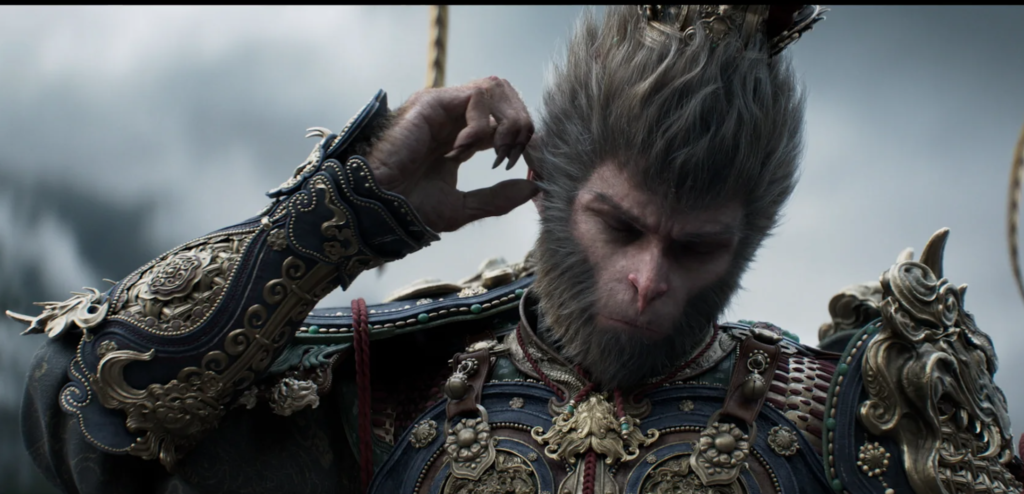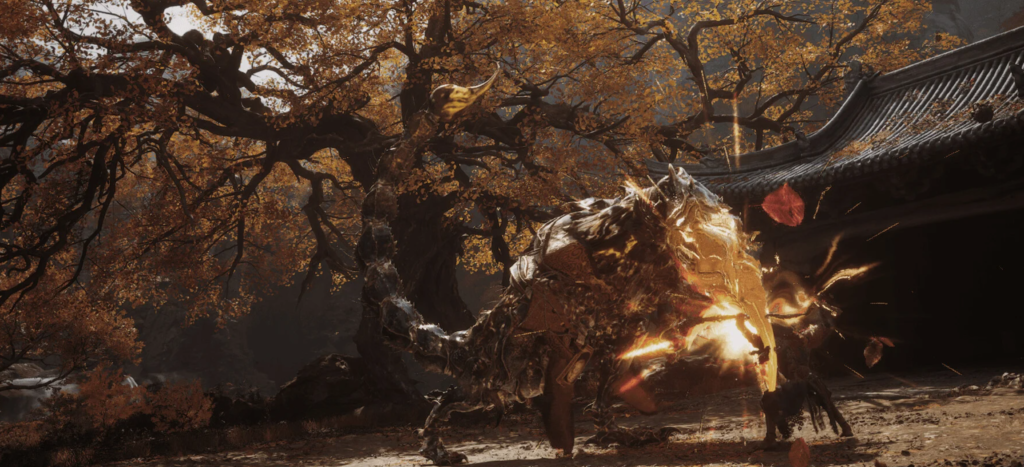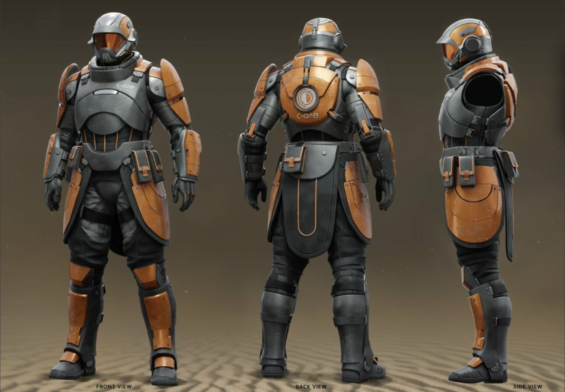By Jerry Williams

A Souls-like based on the characters from a historic novel from 16th-century China that has the quality of a AAA title? Try to make me not play this game. Well, you’re too late because I’ve beaten it despite a frustrating final chapter, and I loved it! Most of the time. If you’re a fan of Nioh—and I love me some Nioh 2—then you’ll find a similar style here in a game that isn’t going to drive you to tears with its difficulty.
Black Myth: Wukong follows a silent, anthropomorphic monkey looking to follow in Sun Wukong’s footsteps, gathering the five relics he left behind so you can complete your reincarnation. I think. I’m not sure, to be honest. Based on the novel Journey to the West, Black Myth has artistic license in what would happen if a monkey—named the Destined One in the game—wanted to become the monkey hero of legend. Honestly, though, I lost sight of the main plot pretty early in the first chapter, as the story largely follows the eccentric characters in each encapsulated chapter.
You, the Destined One, will meet all sorts of odd characters who wish to aid you along the way and maybe help themselves in doing so. A reciprocal back-scratching tale of altruism. Within each chapter, those are the overarching plots, but you may meet a variety of other characters with their own challenges and wishes. These NPC-driven narratives won’t blow anyone away, but the novelty of the tales and powerful personalities will surely delight.
This is a Souls-like, meaning it’s an action RPG with challenging bosses, experience gained, stats and skill trees, and shrines littered about to serve as checkpoints should you fall in battle. Now, how Black Myth departs from the formula is that while bosses can be difficult, I beat most of them on my first try. That isn’t to say they were easy—some of them I was down to my last healing item and out of mana—but others I did away with in a surprisingly brisk fashion. Another departure is the regular enemies along the path, which are almost always fodder. Though these fights are trivial, they’re not unwelcome; they keep the route from point A to B active and add to the world in terms of hostility and visuals.
Many Souls-like fans turn their nose up at easy games in the sub-genre, and I find this tiring. We have no need to gatekeep a game because it doesn’t waste our time. Black Myth is easy and fantastic fun. I wasn’t bored to tears because, while easy, I had to work for my wins. Proper dodging, strategy in building my monkey’s skills and equipment, and understanding boss patterns keep the action mentally active and make victories feel earned. The dodging is generous, and while parrying doesn’t exist, a well-timed roll results in a Perfect Dodge, significantly building the focus gauge and potentially other benefits depending on the skill tree.
Wukong uses one weapon, which helps make a reasonably diverse skill tree that’s balanced around gameplay. However, weapon skills, such as changing Wukong’s stance for different combat abilities, are only one tree. Players can enhance the few spells available, transformations, and core combat abilities, such as enhancing varied combos, jump attacks, and light attacks. This sounds like a lot, but most of it isn’t available right at the start. Chapter one serves almost as a tutorial, though a meaty one, and introduces gameplay elements at an excellent pace.

Spells include abilities folks familiar with Sun Wukong will recognize, such as summoning clones to ambush an enemy. Each spell’s skill tree has interesting options, while transformations—infrequently earned abilities to turn into meaty foes encountered along the way—exist without a tree. Level-ups occur at a decent clip, so be prepared to make difficult, fun decisions about how you want to build Wukong, because you can’t be the best at everything. Made a mistake or need a different tactic? No worries; players can respec at any shrine for free.
Other systems and abilities exist, such as summoning a spirit to briefly change Wukong into a foe—don’t mistake it for transformations—for one or two attacks. Sometimes, spirits don’t even attack but plant a buff in the ground for players to fight around after changing back. On rare occasions, players may find vessels, earned by finding secret dungeons while interacting with the environment; vessels can be game changers and recharge with successful attacks in combat, like focus.
In true Souls-like fashion, NPCs are cryptic, but pay attention to what they say. Oftentimes, a fork in the road or clue to a hidden dungeon lies in their words. Find a weird key item in a chapter you have no idea what to do with? It was likely referenced earlier, and if you weren’t paying attention, you won’t know what to do with it. Sometimes you just have to wait. Folks may take issue with this because in order to unlock everything Black Myth has to offer, doing the “right things” seems to require prior knowledge, though that fits the game’s theme of Buddhism and reincarnation.

I took about 45 hours to beat Black Myth, which includes exploring areas for secrets and finishing quests. For the vast majority of the game, I was having an amazing time. Littered with unique bosses that often present different attack patterns and sometimes introduce elements I’d not seen before in a Souls-like, I was thinking, “How high do I score this?” Then came the final chapter, which introduced an entirely new mechanic to traverse the chapter. Exhilarated, I was wide-eyed at the prospects laid before me. Unfortunately, the execution didn’t land, and while I won’t go into specifics for fear of spoiling, it’s important that readers know I had wasted a few hours aimlessly trying to figure out what to do and how to do it. Disheartening, to be sure. Regardless, I muscled through and finished the game, but I hope the team adds some quality-of-life features to this section in a patch.
Other quibbles I have with this otherwise stellar experience involve how the game handles boundaries in chapters. For the most part, Black Myth plays as a linear game with several diverging paths, be them hills, drops, or turns. Maybe a wall you encountered earlier is gone now. The problem here is the ample use of invisible walls. Now, to present this breathtaking world as beautiful and open as GameScience has, I understand the need to use invisible walls. That said, sections that appear traversable but aren’t may appear later on and be absolutely traversable because a treasure chest lies in the distance. A simple example is a rock that’s about waist high: can’t cross it! Same sort of obstacle later? Totally can. The inconsistency hurts the experience and adds a touch of frustration for completionists who want to check every corner for hidden goodies. All this said, I’m not sure what the answer is, because putting in actual walls everywhere the developers don’t want players to go would hurt the visuals. Maybe some studious designer has the answer.

Speaking of visuals, Black Myth exhausts every opportunity to add detail, whether gazing into the mountains far off a cliff or squinting at the stonework of a wall carved with hundreds of Buddhas. Immersive environments are core to the experience, and anyone with a taste for Asian history, philosophy, or environments is going to love this marvel. Areas in which players have no business looking have detail. Some odd ravine had little statues lying about if you look closely enough, while other carvings have believable moss growing on them or show the wear of time.
Similarly, Black Myth’s voice actors match the script, breathing life into these anthropomorphic teddy bears. Few characters come off as grounded and well-adjusted; most are erratically excitable, overly confident in the most dire situations, or seem immeasurably anxious at all times. I love them all. The music blends into the background, but in critical moments, the Chinese instrumentation—gongs, liuqin, and the like—either accentuates the bombasity of ridiculous situations or heightens the intense battle ahead.
I would be gushing if I were writing this before the final chapter. The finale should not negate the majority of the game, but to cast it aside would be disingenuous. Without a doubt, I had a blast throughout Black Myth. If you have the slightest interest in Journey to the West, Asian philosophy, or want to broaden your horizons, then this is an easy recommendation. Aside from being an exceptional, accessible game to play, the references to works you may not be familiar with will instill an appetite to learn more. I know it has in me. All of this coming from a studio I had never heard of before (GameScience), though I hope it finds great success after their effort here. If this is an example of what they can achieve, I can’t wait to see the next project.




